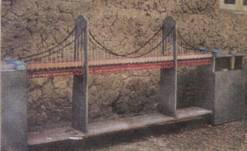A CARPENTER UNRAVELS A TECHNICAL MYSTERY
 |
| Gopalakrishnan, Maruthummoodu, near Kallara, Thiruvananthapuram |
The hanging bridge at Punalur was constructed 125 years ago during the British period. Unravelling its technical mystery would have been a worthy task for the civil engineers of the State. But rather, it is Gopalakrishnan, a small time carpenter from Maruthummoodu, near Kallara, Thiruvananthapuram who has taken pains to study its technical complexities, especially the way the iron girders of the bridge are anchored.
Says he: “Contrary to what many believe, the iron girders of the bridge are not fixed at the bottom of the wells found at the two ends. It is actually placed some two or three feet away from the base of the well.”
How can he be so sure when no one has gone down the well? Simple: “Just watch closely and carefully and one could find that the iron girders, which hold the bridge are not in line with the well.”
Then why was the 15-feet well constructed? “For workers to slide down and keep the girders from getting rusted”, he says confidently. “Unlike domestic wells where the circular landings are just 2 to 3 feet apart, here it is some 8 feet apart. And the workers use an 8 feet iron ladder to slip down the well. Standing on the first landing, the workers place the very same ladder to go down the second 8 feet. Using more than one ladder would be dangerous as a small slip could lead to disastrous consequences.”
His speculations are manifest in a 7 feet working model of the bridge he has constructed. And the confident carpenter makes this grand claim: “I can rework the hanging bridge of Punalulr. I can even build other hanging bridges of its kind. If only I am given my due, I will part with the whole secret”. Would the brains-that-be care to examine the claim of this rustic carpenter-cum-engineer?
He is applying finishing touches to another wonder – the first walking stick made of coconut shells.

Courtesy: R. Ayyappan, The New Indian Express (October 17, 1998)
Contributed by: Administrator
